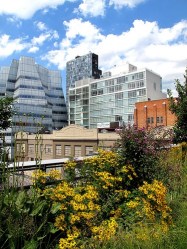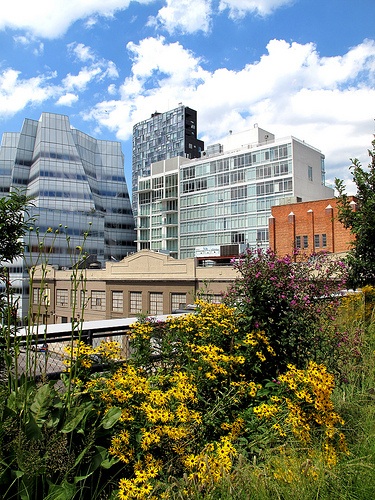
Photo by Victoria Belanger
Of everyone I saw in all the New York City parks I visited this weekend — the cool kids eating organic popsicles on the High Line, the svelte ladies jogging the Central Park Reservoir, the older man in a Speedo sunning himself on Hudson River Park lawn — one couple made me question my idea of what parks are and how they should be within a city.
They were at the top of a small set of white marble stairs, perched on a bench by a fountain in a tiny park on 58th Street, between 5th and 6th avenues in Manhattan, so tucked away from the bustle they (and the park) likely went largely unnoticed by busy passersby.
I’d just fought a throng of tourists for park bench space in Central Park, and it struck me, watching this couple, that parks don’t need to be grand, historic, hundred-acre, designed spaces. They can be tiny pockets, like this one, squeezed in wherever there’s room. And they can be part of the connective tissue that holds a city together – like the High Line, or Hudson River Park, which serve as both destinations and means for getting from one place to another.
Helle Søholt, co-founding partner and managing director of Gehl Architects in Copenhagen, Denmark, was able to articulate this idea more clearly at the keynote panel discussion of the Greater and Greener International Urban Parks Conference, which I’d come to New York to attend. “Parks in the U.S. are seen as destinations,” she said. “In Europe, they’re thought of more as public spaces between buildings — the green glue that holds a city together.”
Copenhagen, being the Portlandia of Europe, has a plethora of green glue, due in large part to the labyrinth of bike lanes that wind through the city (to take a whopping 37 percent of Copenhagenites to work). The city just opened its first “bicycle superhighway” — which is less a freeway than a bicycle-only, tree-lined path that meanders through the city and its surrounding countryside. It is the first of 26 planned routes.
But America’s not so far behind — New York least of all. Launched in 1996, the Greenstreets program has transformed much of the city’s negative space into green space. Greenstreets started small — planting a flowerbed here, a few trees there — and gradually began improving existing infrastructure, like awkward intersections. What once was a concrete median or a matrix of painted lines, for instance, became a raised bed with shrubbery, sidewalks, and crosswalks — even a bench or two.
From there, it grew. Now, Times Square and Madison Square, historically two of the busiest intersections in New York, are pedestrian paradises — with potted plants, wider sidewalks, and café tables (just like in Europe!).
“One of the reasons this has been happening in New York for a lot longer than the rest of America is we don’t have the luxury of space that a lot of other places do,” says Nette Compton, director of green infrastructure for the New York City Parks Department.
Of course, New York isn’t the only American city thinking outside the parks. Minneapolis’s Grand Rounds Scenic Byway has 52 miles of roads, bike paths, and walkways that link downtown’s riverfront and the city’s surrounding parks and lakes. Houston’s Buffalo Bayou, an interconnected series of parks and bike paths, aims to preserve the ecosystem of the waterway and reinvigorate existing brownfield sites and unused freeway corridors.
The idea of a linked park system is not new, mind you. Frederick Law Olmsted’s Emerald Necklace in Boston (one of the man’s many linear park systems) connects 1600s-era Boston Common to Franklin Park in a nearly eight-mile series of greenways that includes the formal promenade of Commonwealth Avenue.
But the Big Apple is taking an especially holistic approach. Greenstreets is now a centerpiece of the city’s effort to enhance inter-departmental collaboration — part of Mayor Michael Bloomberg’s three-pronged approach to maintaining and enhancing city parks. The program brings together New York’s Department of Parks and Recreation with the departments of Transportation and Environmental Protection.
A successful Greenstreet is what Compton likes to call “hyperfunctional” — wider sidewalks mean a more pedestrian-friendly environment, and directing storm water onto planted beds controls runoff and provides needed water to those plants (which otherwise would have to depend on periodic visits from guys with hoses on trucks).
“It’s all about efficiency,” says Compton. “And New Yorkers — we’re all about efficiency.”
Garry Golden, a futurist who studies issues that will affect transportation and business in the 21st century, imagines that the future of urban parks will look a lot like Greenstreets, with parks woven throughout the rest of the city’s infrastructure. “What’s the future of potential park real estate? What are the new parts of the city that you might take control of?” he asks. “Parking spots.”
Ten to 20 years from now, he predicts, cars will be replaced by better public transportation, including self-propelled, on-demand, pod-like cars. (Remember Minority Report? Like that, only real.) This means streets will no longer be lined with cars. “The next step is you see building- and homeowners saying, if we don’t need as many parking spaces, let’s transform that piece of the urban landscape into something that’s urban and green” — i.e., more bike lanes, and Park(ing) Day-like parklets.
It occurred to me, after around 48 hours in New York this weekend, that I had visited more than six bona-fide parks. A run in Central Park, then a walk through Washington Square Park on the way from the subway to the conference, a quick walk with a friend on the High Line, then, when we realized the High Line doesn’t allow dogs, a few blocks over to Hudson River Park. Later, I stopped in Madison Square Park to use the public wi-fi — an easier (and cheaper) option than Starbucks when I needed to write some quick emails.
It was seamless, this park-hopping — a testament, in part, to Mayor Bloomberg’s goal to have every New Yorker live within a 10-minute walk of a park. But soon, it seems, that goal will be outdated. The walk itself may well appease our nature-loving psyches. And as the rest of urban America (and the world) continues to run out of space, there’s reason to believe we’ll take a cue from New York, and start filling in the cracks with green space. Not only will it make our walks prettier, but, like Greenstreets, it just might make the city more efficient. That’s what happens, after all, when you make a little room for nature in the concrete jungle.



